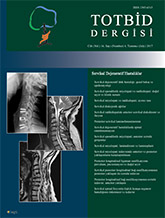
Cervical discogenic pain is the second most common disease among all spinal intervertebral disc diseases with a rate of 36%. One of every five orthopedic examinations is associated with cervical discogenic pain, and 75% of these pains are of C5-C6 and C6-C7 origin. This disease group which is more common in females, accounts for 2–3% of injuries in contact sports. Cervical spine movements include flexion and extension in sagittal plane, lateral flexion in coronal plane, and rotation in horizontal plane. Lateral flexion and rotation are commonly seen together. Other cervical movements are protrusion and retraction. Prolonged sitting in a bad position, frequent neck flexion, sudden movements and trauma are the predisposing factors in cervical disc diseases. A good history is essential for assessing a patient with cervical pain. It is very important for the treatment to distinguish whether the problem is spinal origin and/or related with a serious problem. Inspection, palpation, and motor-sensory-reflex examinations should be performed at the physical examination. Direct radiographs, MRI and other special tests play important role in diagnosis. Most of the cervical discogenic pains can be treated by aggressive conservative treatment methods. NSAIDs, short-acting steroids, non-narcotic analgesics and short-acting narcotics may be used for medication. Selective surgery should be recommended for non-healing patients with selective injections, and comprehensive rehabilitation program. The prognosis of patients with cervical radiculopathy is excellent with appropriate treatment. Non-operative treatment options are effective in 80–90% of patients.